Anson says that the company has defined 115 distinct tasks involved in putting out an adventure, and many of those tasks involve creating and refining a story. Everything is planned; frequent meetings are integral to every step of the production. Ideas for the plot of the game, the characters, the puzzles— all are tossed around at these bull sessions.
(Continued from my previous post.)
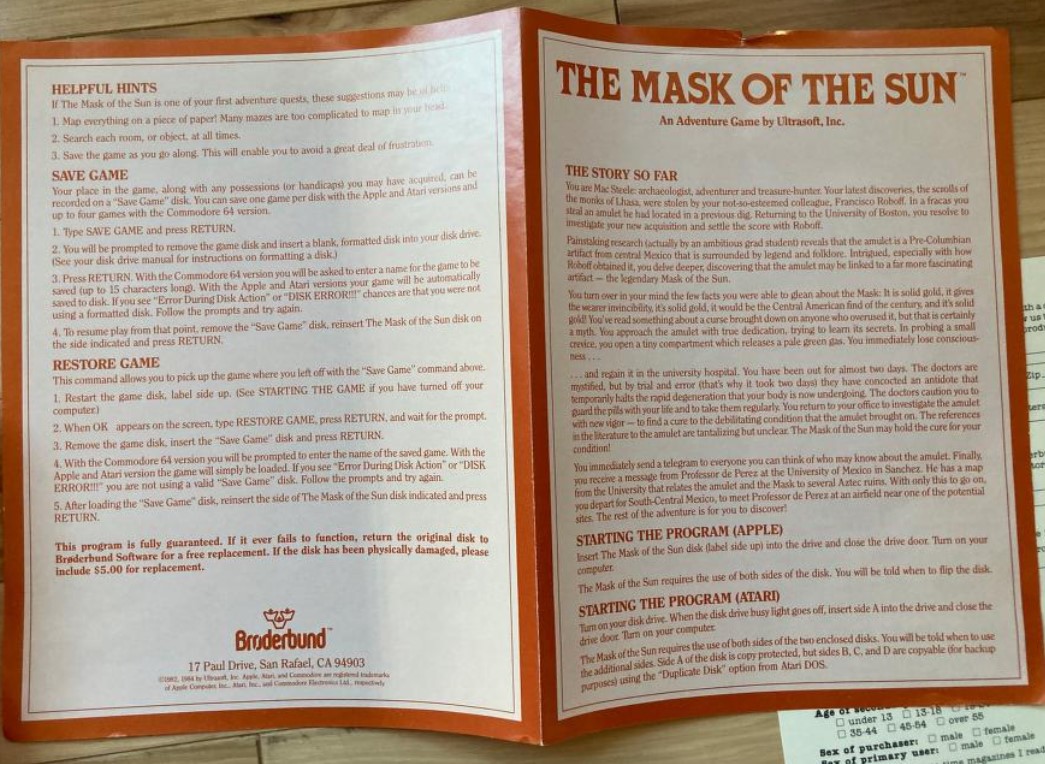
The manual for Mask of the Sun from the later Brøderbund printing, via the Internet Archive.
So before getting back into the gameplay, I wanted to discuss the game’s parser, which I hinted last time left something to be desired. The Softline article I quoted last time certainly tries to pump it up:
Ultrasoft’s parser is based on concepts of artificial intelligence. In any given message, it eliminates words that don’t make sense and attempts to make sense out of words that are relevant to the situation. This method frees the player from the verb-noun format of the typical adventure’s input. Consider: If you’re in a room with two men, one old and one young, in an adventure with a two-word parser, you might have to make several tries before finding the correct verb-and-noun combination that expresses your wish {as to what is correct, the arbitrary decision of the programmer is final).
In Serpent’s Star, there is just such a situation. But with the Ultrasoft parser, you can type, “Co sit with the old man at the table,” and the parser extracts the operative words “sit” and “old man” and sits you down next to him. Once you’re familiar with what the operative words are, you can just type “old man” and know the parser will understand. Many of the verbal “puzzles” of the two-word parsers are really only hindrances to realistic game play. After all, you can only put up for so long with messages like “I don’t know how to OLD something.”
I can’t comment on Serpent’s Star (Ultrasoft’s second game which we’ll visit in ’83). I will say this game’s parser has serious issues, and their handling of the issue cited above is terrible.
For example, there is a scene early with a jade bowl. You can GET BOWL and the game will react like you’d expect. However, immediately after, trying to EXAMINE BOWL gets:
I don’t recognize an object in “EXAMINE BOWL”.
??? I was seriously baffled for a while until I realized EXAMINE JADE BOWL was what worked. So not only do most actions require the adjective, the game inconsistently requires it, so one scene you can refer to the bowl as a bowl while the next you can’t.
As another example, let me pull up my verb-testing list for the game.

This represents me going through the list and typing each word alone. Sometimes the word genuinely works alone (DIG: “DIG doesn’t work here.”) but usually the response on one of the green-marked words is something like:
I don’t recognize a noun in “CLIMB”.
Fair enough, although I should point out using grammar terms isn’t the greatest way to do this; “you need to say what you want to climb” would be better. It’s better to explain why something went wrong in a game from the perspective of what the player needs to fix rather than from the perspective of what caused the computer to be confused. That isn’t what the main issue is, though. Take USE:
I don’t recognize a noun in “USE”.
This made me think USE OBJECT might be useful in some circumstances, but here’s the response to USE ROPE:
I don’t recognize a verb in “USE ROPE”.
Which straight up comes across as a bug. I’m still not sure what to make of it. Does this mean that USE will work somewhere, but only in a very specific place, just like you can refer to the “jade bowl” as just a “bowl” but only when taking it? This wild inconsistency is far, far, worse than dealing with a two-word parser.
At least two-word parser give you their restrictions up front. Here I’m paranoid about guess-the-phrase showing up, and it isn’t like removing “excess words” like THE is that big a deal (another thing the manual touts).
Enough grumping, let’s move on. Last time I entered a ruin and was cut off in darkness, lacking a match to light my lantern. I missed possibly the most obvious thing to try, which was to check my inventory in case I had something helpful to start.

So we get a box of matches, knife, bottle of pills, ancient amulet, and loaded revolver in our inventory as the adventure begins, added onto immediately by the shovel, lantern, food, rope, and map from the jeep. We’re actually well equipped! (Like you would expect to be true on a real adventure!) I’ve observed before getting a lot of tools to start is pretty rare, even though in a verisimilitude sense it would match better with the situation. I’m wondering if this is a positive effect of the “strategic planning” element of Ultrasoft; that is, they thought about adventures at a “meta level” and wondered themselves why so many of the games start you with nothing.
Of course, because this is the Ultrasoft parser, trying to refer to a the match box is futile, and I mean totally futile.
I don’t recognize a noun in “OPEN BOX”.
I don’t recognize a verb in “OPEN MATCH BOX”.
I don’t recognize a verb in “OPEN MATCHBOX”.
I don’t recognize a noun in “OPEN”.
(Just like USE, yes.) I eventually puzzled out I could just LIGHT MATCH straight up, so even though you don’t see individual matches in your inventory, you can still refer to them. Look, this sort of thing is a nice quality-of-life feature to jump straight to pulling out a match, but that doesn’t mean you get to skip the player being able to refer to the box itself. What if there’s a limit to the number of matches? Maybe there is, I don’t even know.
(Incidentally, back to the inventory, those pills are “your lifegiving pills” and you start with 97 of them. I assume you have moments where your curse-illness strikes, so they’re for lasting a little bit longer. Good atmosphere, that.)
With the lantern lit I was able to enter the first ruin properly, and see what was hissing. What you’re about to see is a series of animation screens, and the animation keeps going as you type. If you wait long enough you’ll die.

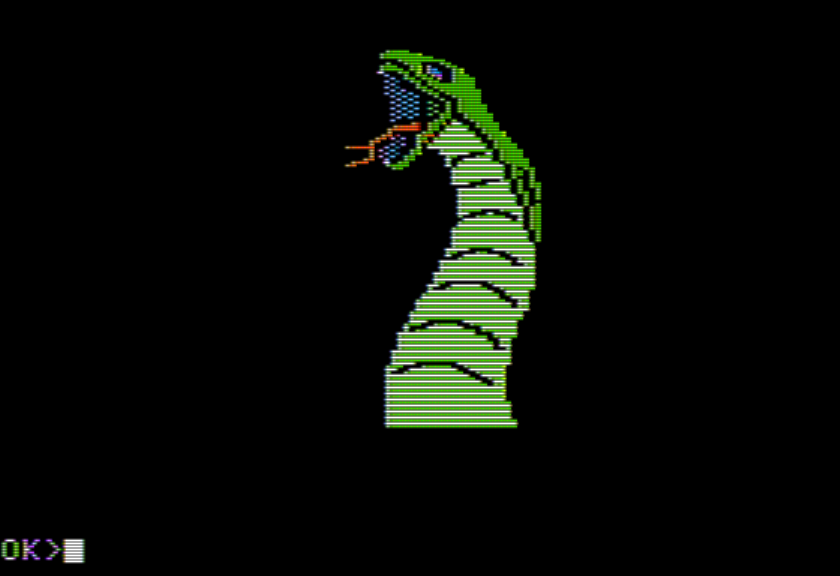


The final screen immediately triggers after typing SHOOT; you don’t even hit enter. (Bespoke! So much for their advanced parser. But this time it worked out in practice.)
This leads to a room with a pedestal and a left and right passage. Compass directions are now out. You have to type LEFT or RIGHT or FORWARD or BACKWARD to move, and sometimes the directions are relative (that is, if you enter from the east, going right will be north) and sometimes they’re not and just based on the image that you see on the screen (so the passage on the RIGHT will always be oriented that way in a particular room, no matter how you arrived at the room).

RIGHT and LEFT are both dead ends.


Your companion will lower a rope you can climb, so this is a “cinematic set piece” rather than a puzzle.
If you try to EXAMINE the pedestal the game says you should search further, so SEARCH PEDESTAL instead gets a secret door you can open:


Further in is the jade bowl I was complaining about earlier.
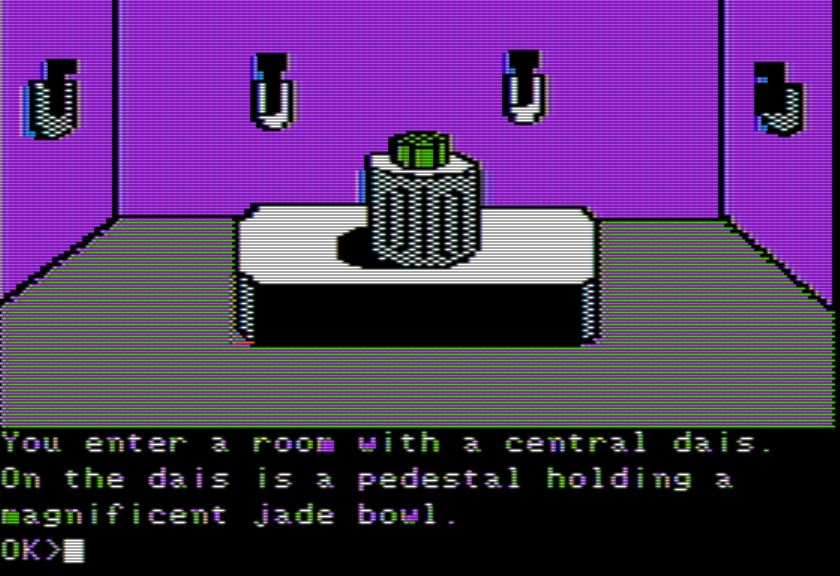
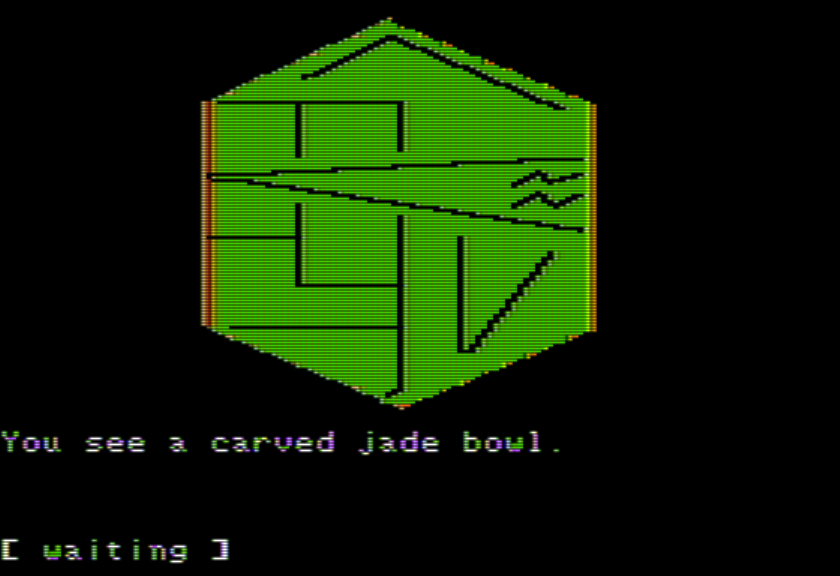
If you pick it a trap triggers and the room brings you down to another level.
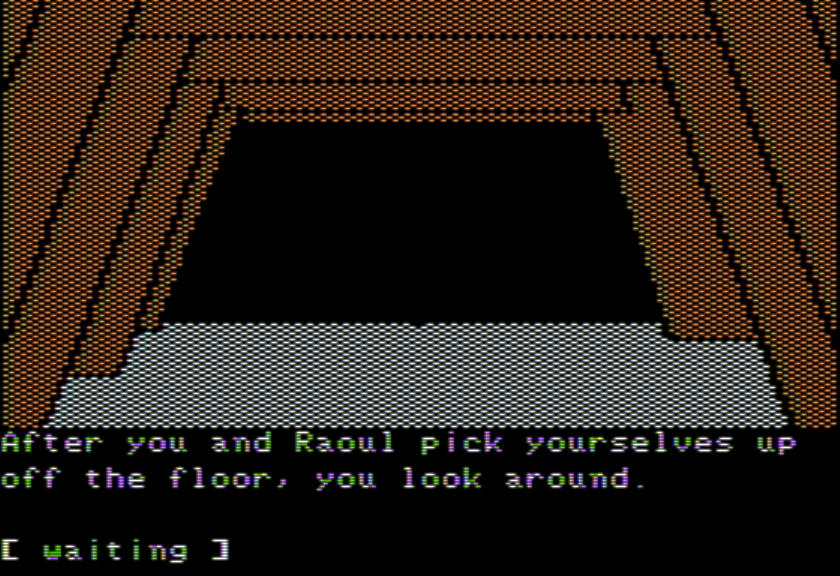
In one direction is a teetering boulder, and it is honestly atmospheric as the boulder is animated teetering in real time. I haven’t managed to get it to trigger even on purpose for an amusing death message.
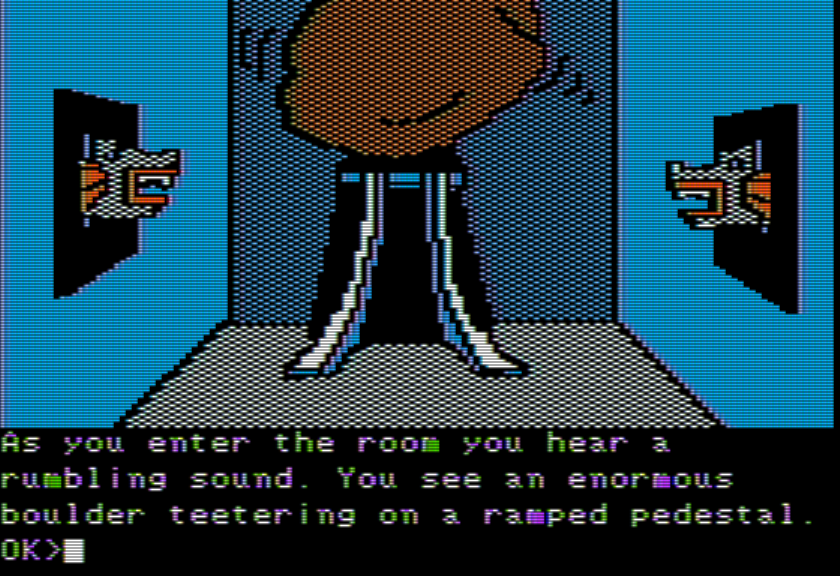
In another direction are some sarcophagi. You can get Raoul to help you open one, revealing a spirit.
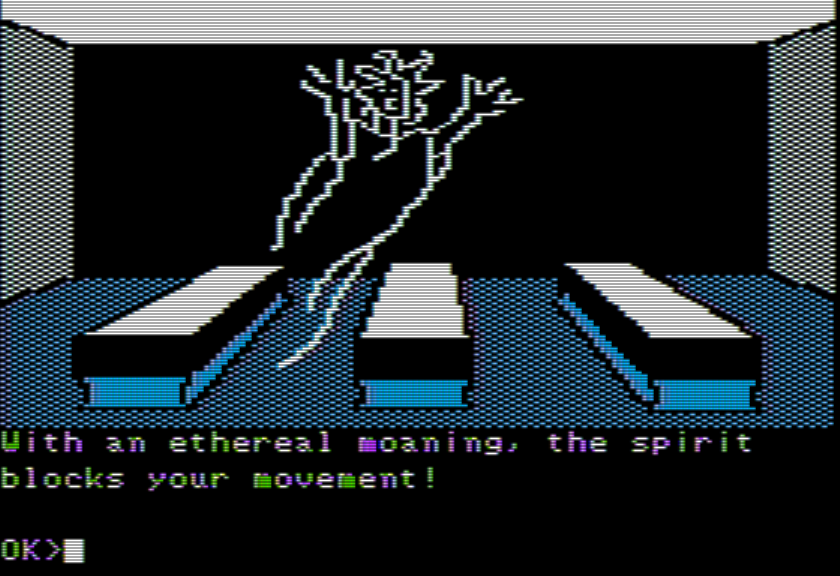
Just waiting long enough seems to cause the spirit to go away, leaving a gold bowl.
In a third direction is another branching area. Moving a heavy urn from one pedestal to another opens a passage to the outside, so you can go back to the jeep.
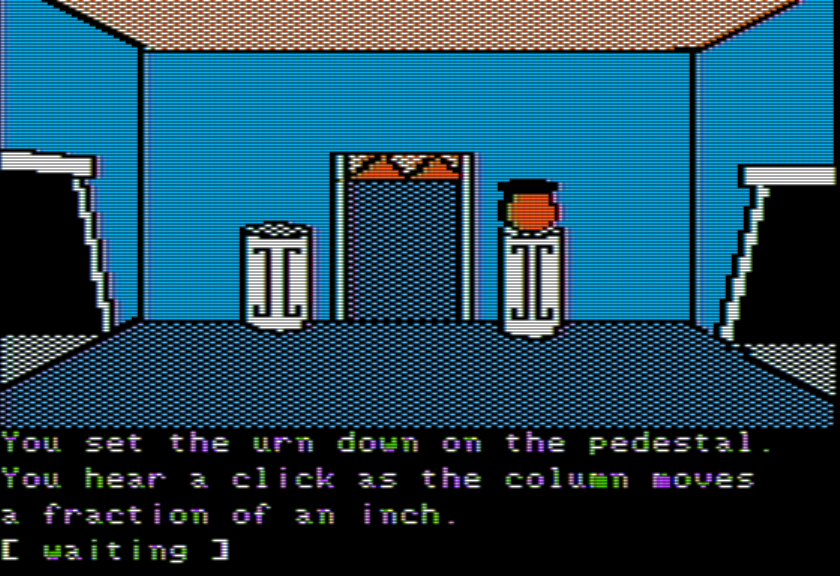
Going to the “right” leads to some skeletons guarding a silver bowl (remember I already have jade and gold). However, the skeletons wake up and defend this one, Harryhausen-style, and even animate kind of like Harryhausen.
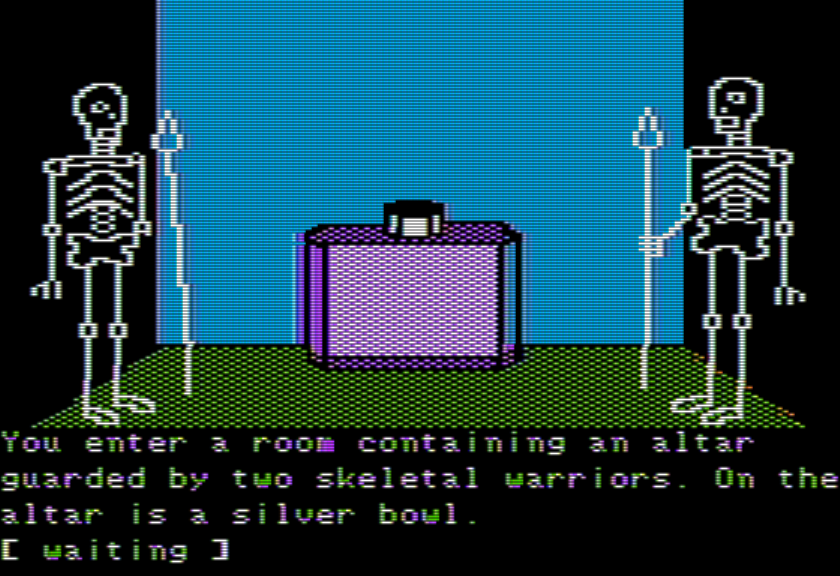
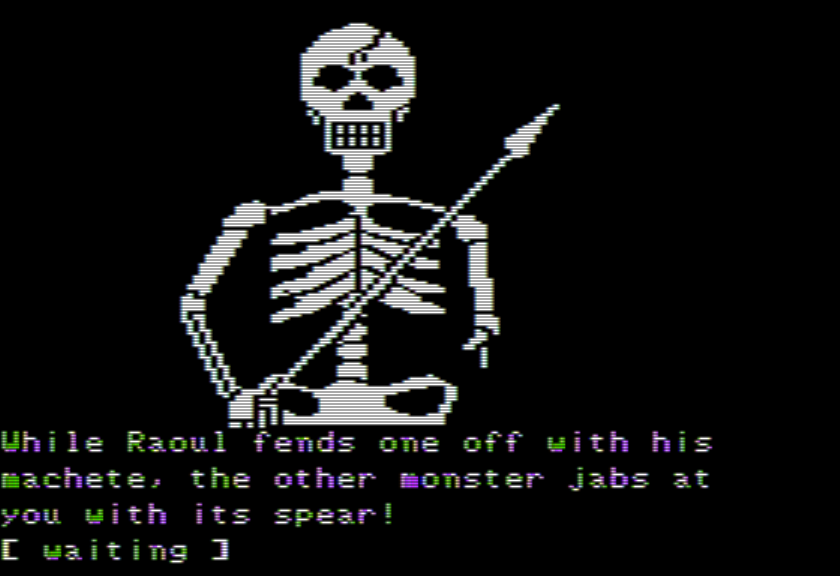

This animates as you are typing, just like the snake.
Again, waiting too long kills you, and this time (admittedly as expected) the gun doesn’t work. I’m still not sure how to deal with the skeletons; I don’t know if I’m supposed to be yet. I kind of want the boulder to kill the skeletons but I can’t get it to trigger and based on the map I don’t think it’s a straight shot. (If you run away, the skeletons just resume guarding position, so you can’t lead them over.)
The reason I feel like I should deal with them now is the game has been structured so far more like a gamebook than a standard text adventure. By which I mean: lots of self-contained set pieces, left or right branches that sometimes lead to nothing, and the general feel of “cinematic scenes” akin to Arabian Adventure more than a big looping puzzle-box. I’m not far enough in to be certain, though.
It seems like maybe the parser looks for a noun first, complains if it doesn’t find one, and then looks for a verb? Which is the opposite of the order we’re used to, but since it’s basically described as a keyword parser, that might be more plausible than with two-word-plus parsers that want to find the verb first and then see what’s going on.
On the other hand, on this theory it recognized MATCHBOX as a noun but not OPEN as a verb, and it looks like OPEN did work as a verb elsewhere, which might suggest that it’s looking for a noun first, looking for a verb that works with the noun, and then issuing a really terrible parser message if it doesn’t find an appropriate verb. “I don’t recognize anything I can do with the matchbox” would be much more helpful if that’s the case.
And the stuff you describe with the jade bowl is very bad. I can come up with a theory about why that happens, maybe the bowls never get picked up except in their original location so there’s no need to disambiguate them when you’re getting them, but it’s not a theory that means it should happen that way.
Anyway does the amulet do anything? Can you wear it?
“I don’t recognize a verb in WEAR AMULET.”
Yipes, and with WEAR on your verb list, that definitely suggests that “I don’t recognize a verb in…” is looking for verbs that specifically match the noun. Bad parser! No biscuit!
This one really feels like a bunch of much more modern trends in game design accidentally merging together into a much more period appropriate package. Getting timed as an (animated!) enemy slowly closes in on you is a trick that would become a standard one in graphic adventures, though with parsers it’s clever for a moment. The gamebook approach is a modern choice of course. Attempting to make an intelligent parser…well, maybe they’ll get them next time. It’s certainly possible to make very clever parsers around this time, but seeing as a lot you could “cheat” by typing tak mat or something.